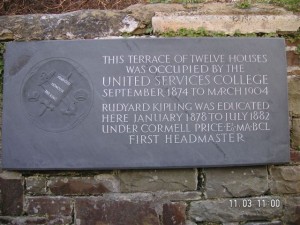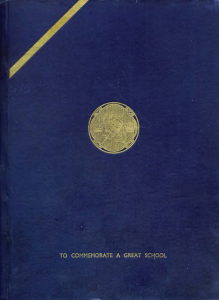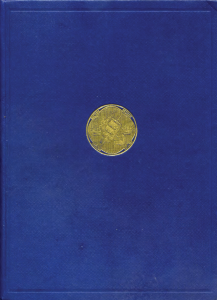United Services College
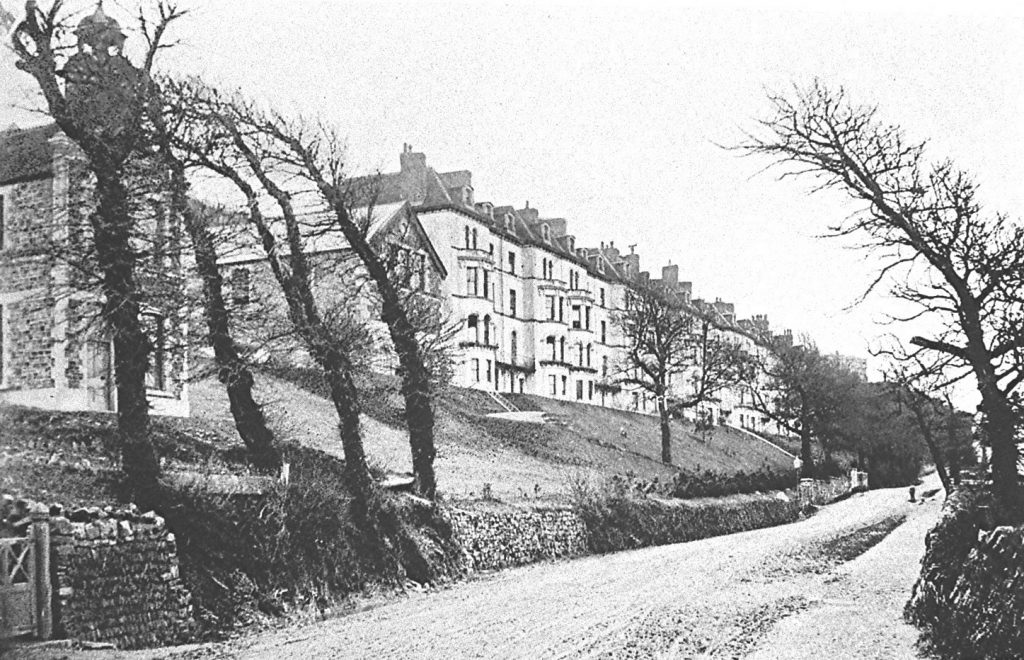
The college was founded in 1874 by a company of army officers.
At that time, in the heyday of the British Empire, large numbers of Englishman and Woman lived abroad for much of their lives, working to run the Empire around the world, in the Armed Forces or in civil organizations such as the Indian Civil Service.
Many wished their children to be educated “at home” and one of the roles of the USC was to educate the sons of ‘expat’ Englishman, mostly Army officers, preparing boys to go straight into Sandhurst or Woolwich to train as Officers themselves.
In 1878 a small stocky bespectacled boy arrived from Lahore India, soon to be named ‘Giglamps’, young Rudyard Kipling (1856-1936) arrived in Westward Ho! His days at United Services College are remembered and recorded in the book ‘Stalky and Co’:
“One windy winters night Stalky Mcturk and Beetle (Kipling) turned a key and beheld a miracle…. They heard him groping in the wet, and presently beheld a great miracle. The lights of the Coastguard cottages near the sea went out; the brilliantly illuminated windows of the Golf-club disappeared, and were followed by the frontages of the two hotels. Scattered villas dulled, twinkled, and vanished. Last of all, the College lights died also. They were left in the pitchy darkness of a windy winter’s night.”
They had of course turned off Molesworths gasometer.
Another pupil of the college was Bruce Bairnsfather, the artist and creator of “Old Bill” famous during the First World War.
The USC failed financially in 1903 and the boys were relocated twice to other schools in Harpenden and Richmond merging with St.Marks Windsor, existing to this day.
In 1942 after being named the Imperial Services College it amalgamated with Hailbury College.
Molesworth started a second college, which now comprises Cleveland Terrace. It was designed for the sons of Doctors, Lawyers and Clergyman. The reasons for its closure remain obscure but in December 1885 it closed down and is now Flats.
Gazettte, 3rd May 1904:
A suggestion has been made that the USC at Westward Ho! should be acquired by the County of Devon and utilised as a training college. The Staff and Boys at the United Services College Westward Ho! are to be transferred, according to Lord Chelmsford on April 29 to the new quarters at Harpenden. A Junior College will be kept on.
In 1978 Mrs Janette Tribe, her husband Phillip, and brother David Peel all young graduate teachers bought ‘OVERBOROUGH’ restored the building and opened as ‘KIPLING TUTORIAL COLLEGE’ . They adopted the United Services College’s badge and motto, and had the girls residential unit in Fosketh Hill. The students mainly foreign and used the eight houses of the Terrace that had been bought under certain covenants from Torridge Distrct Council. The College though was very short lived and was as a Limited Company liquidated in 1981.
Plan for the Junior School:
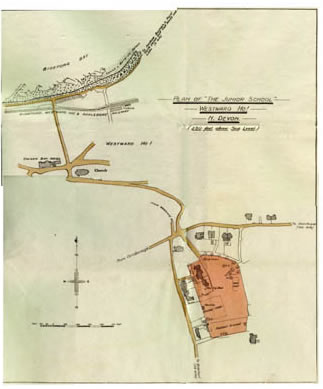
The Junior School was closely associated with the United Services College. Established by the College authorities in 1879, in a private house at Buckleigh. With the names of just 15 boys appearing on the first rolls, the school was to operate for five terms, before relocating to ‘Edgehill’ a house on the hillside above the College in 1880, this was previously used as a school for the very youngest boys aged six to nine years. The junior school operated successfully until the early 1890’s when numbers had fallen to such a low level that its future appeared uncertain. The appointment of a new Head, Mr R J Leakey however secured the schools fortunes and the junior school remained an existence in Westward Ho! Until 1914 when Leakey retired. After the departure of the USC the junior school was run and known as ‘Mr Leakey’s Junior School’ independent of the USC.
1874-1904
Kipling Terrace was built in 1869 the architect was Edward Willmott. It was originally called KINGSLEY TERRACE and consisted of 12 houses in pairs on 5 levels. The 1871 census shows that only a few of the houses were occupied.
It was with great relief to the shareholders of the Westward Ho! Villa Company that they managed to secure a 30 year lease on the terrace and it became THE UNITED SERVICES COLLEGE IN 1874. The college was created to provide the sons of officers with a less expensive education than some of the other public schools. This was needed because examinations had been introduced to become an officer in the navy or army.
Before this officer promotion was based on wealth instead of military skill. The Limited Company was founded by Major General Sir Charles Daubeney and a number of other officers. Shareholders in the company could have their children educated at a reduced rate. The conversion of the terrace was carried out by the Barnstaple architect W.C. Oliver.
For the college to become a success a good headmaster was required and the choice fell upon Mr Cormell Price. Educated in Birmingham and then Oxford, he was the life-long friend of the artist Burne-Jones. After Oxford he went to Russia and then returned to become head of modern side at Haileybury College. He was a remarkable kind man with liberal views and a perfect choice.
The college opened its doors in September 1874 with 60 pupils mostly boarders with a few day boys and a well qualified staff. The playing fields stretched down from the college to the sea, the cricket field is still in use today.
The college numbers grew to about 200 and 75% of the parents were abroad in the services, many in India.
The boys were divided into “houses” each under a House Master. Houses were tribal and there was great competition between houses in both sports and academic fields, with trophies regularly competed for in both
Subjects were Latin, Greek, Mathematics and the Sciences. When the boys became seniors they were given individual tutoring to prepare them for Sandhurst or Woolwich.
Commemorative plaque
In the Kipling Journal no: 108, December 1935 pp13-14 it is recorded that a Commemorative Plaque was unveiled in September of that year at Kipling Terrace.Westward Ho! by Lt.General W G H Vickers president of the United Services College and Imperial Service College Society. Originally named Kingsley Terrace, the ‘twelve bleak houses’ were re-named earlier that year to honour Rudyard Kipling by Northam Urban District Council at the request of the U S C and I S C Society.
The original plaque was subscribed for USC old Boys, their relatives, local residents and members of the Kipling Society. It was designed and executed by R C Fox of the Bideford School of Art, and was placed on the retaining wall of no.7 Kipling Terrace which was the home of the three Headmasters. Cornell Price, Rev. Dr P C Harris, and Rev. F W Tracy. Over the years, it had become lost amongst ivy and other undergrowth, but in 1990’s was rediscovered by members of the Westward Ho! Community History Project (WHCHP). In recent years the Welsh veined slate from which it was made had become badly eroded, and so with a grant from the Northam Town Council, the History Group commissioned John Short, a Bideford Monumental Mason, to restore it. Another Ceremony then took place on 20 March 2010 to celebrate the restoration of the Commemorative Plaque, more than half a century after the original installation.
One interesting parallel between the two ceremonies is that both were attended by relatives of some of the people disguised in Stalky and Co. In 1953 present were Mrs E Bambridge (Kiplings daughter), Miss A M Willes (daughter of the School Chaplain), Miss V Schofield (daughter of Sergeant Major Schofield).
At the subsequent ceremony Lorraine Bowsher (the grand-daughter of Cormell Price) was there.
At the 2010 ceremony Mrs Anne Hulbert gave a short speech on the history of the Plaque.
Bideford Gazette, 16th May 1939:
Torridge Chat
Westward Ho! Schooldays.
Reminiscences of fifty years of Army life together with schooldays at the United Services College Westward Ho! are contained in a book published ,entitled”Life of an Irish Soldier” by General Sir Alexander Godley published by John Murray at 12s 6d.
Sir Alexander says that he enjoyed his life at Westward Ho! very much and he made many friends there, most of whom went into the Army.” The war records of the school he writes is very remarkable. Capt Hon.A Hore -Ruthven (afterwards Lord Gowrie) Major E.D.Brown (Col Brown-Synge-Hutchson) F.A.Maxwel. Brig-Gen G W St. G Grogan and Capt. Anketell Read won V.C’s. many members of the school rendered conspicuous service in the Great War. Gen. G Little,Lieut-Gens Sir Chas Goodwin,and Sir Sydney Muspratt. Major Gens Dunsterville, of Dunsterforce,Sir Archibold Ritchie,Sinclair
Maclagan, Bernard James, Hubert Hamilton F E Coningham,Wagstaff. Bl’omfield, Sir Hugh Simpson Baike, Sir Edward Evans (who was my fag ) Rimington(R.E.) Sir Horace Marlelli, W L Williams G G and S G Loch and Powell were among those attained to high rank.
Brigadier Generals were innumerable. Hubert Hamilton was Lord Kitchener’s trustee military secretary Frank Maxwell V.C. was his favourite aid-de-camp. Both were killed in action. Hamilton commanding a division and Maxwell a brigade. Other well known O.U.S C’s are Capt. Bruce Bairnsfather, the author artist and creator of ‘ole bill’ Brig Gen Sir Rollo Grimston, ADC and Commander of the body guard of the Viceroy of India and Equerry and Military Secretary to the King.
Association with Kipling
The author recalls that he slept in the same dormitory with RUDYARD KIPLING and that his housemaster PUGH and DUNSTERVILLE are two of the prominent characters in ‘STALKY and CO”
He cannot truthfully say that Kipling was popular among his school fellows.”He was too clever for us” he says.”He edited the school magazine and I think realized that he would probably achieve a measure of success in the litery world.” I met Kipling occasionally in after life the last time when he paid a visit to Gibraltar and it is nice to think that prominent among objects of the National Memorial to the great poet and imperialist is the establishment at his old school of Kipling Scholarship. I managed to get into the school X1 captained it during my last year and have pleasant memories of the matches played not only on the school grounds but all over Devonshire. The school he says eventually moved to Windsor where the old Westward Ho! traditions are enshrined.
He is a member of the Governing body.
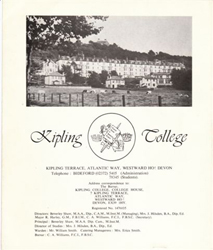
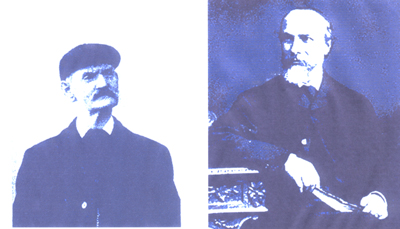
(left) George Schoffield (The weasel) Foxy in Stalky and Co. from a photograph taken by J W Vickery in 1904.
Buried with Military Honours 1st July 1907
Inscription on Memorial Cross in Clewer Cemetery, Windsor:
In memory of Sergt-major George Schofield,late of H.M.76th regt of foot. died 28th June 1907 aged 68.
From August 1879 to June 1907 The Faithful Servant of the USC Westward Ho! and Windsor.
This stone is erected in grateful remembrance by Old Boys of the College.
(right) Cormell Price Esq M A Headmaster United Services College 1874-1994 Known affectionately as ‘ Bates’ Immortalized as the ‘Head’ in ‘Stalky and Co’ Died 4 May 1910 aged 74
College with Rose Gill
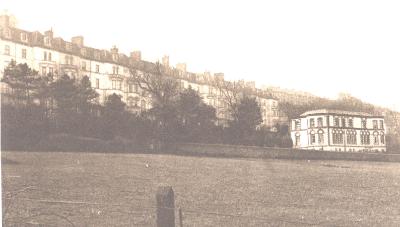
School Uniform
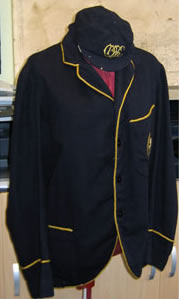
The uniform has been placed in a glass frame and is displayed from time to time in the old school room of the Kingsley Hall, Westward Ho!
An e-mail from Robin Kelsall, from Scotland. He was in the process of cleaning his attic and had come across some items that belonged to his grandfather which he thought might be of interest to us. He had found ‘A Christmas Pastimes’ programme dated 19th December 1882 with the names of all who took part, the ‘School Rules Book’ and an ‘1888 Prospectus’ with a full list of patrons, tutors and pupils, but, best of all, a blazer and cap dating from the time Rudyard Kipling was at the school. The Kelsall family lived at Youngaton (Village Inn), Nelson Terrace and Dunluce until 1956 and their sons went to the United Services College.
The following is the copyright of Lorraine Bowsher 2009
CORMELL PRICE (1835 – 1910)
Cormell Price, the first headmaster of the United Services College at Westward Ho!, was born in Birmingham in 1835. There he attended King Edward’s School where he began a lifelong friendship with Edward Burne-Jones, who would become arguably the most famous of the Pre-Raphaelite painters.
In 1854, Price went up to Brasenose College, Oxford.
Burne-Jones was already there at Exeter College where he had become friendly with a fellow student, William Morris, destined for a brilliant future as a designer, poet and socialist. Through this connection, Price automatically became a member of ‘The Set’, later called ‘The Brotherhood’, comprising a group of young men mainly from Birmingham who, together with Morris, appropriated the ideals of the original pre-Raphaelite brotherhood of Rossetti, Holman Hunt and Millais.
Whilst at university, Price made three contributions to the Oxford and Cambridge Magazine, funded by Morris, which was published in 1856. These were an essay on ‘Shakespeare’s Minor Poems’; ‘Lancashire and Mary Barton’, a response to the novel by Elizabeth Gaskell; and ‘Unhealthy Employments’ (written in collaboration with another member of ‘The Set’, C.J. Faulkner).
After taking an Upper Second in Mathematics and becoming a Bachelor of Civil Law, Price studied medicine for eighteen months at The Radcliffe Infirmary, but gave up when he found himself unable to tolerate the operating theatre during his clinical practice in London. In 1860, by now sorely in need of an income, he became tutor to the son of the Russian Count Orloff-Davidoff, spending the next three years with the family at St Petersburg and Otrade.
Returning to England in 1863, Price took a teaching post at Haileybury College in Hertfordshire, originally the East India Company College, often referred to as the ‘School for Empire’. Here he rose to become Head of the Modern Side, which offered a broader alternative to the Classical curriculum based entirely on Greek and Latin. This Modern curriculum allowed Haileybury pupils to apply to Woolwich and Sandhurst without the need for Army Crammers which had come into being after the introduction of the Army Regulation Act of 1871 abolishing the purchase of commissions.
In 1874, Price was appointed Headmaster of the United Services College at Westward Ho! in North Devon, founded by a group of serving and ex-Army officers to provide an inexpensive education for the sons of military personnel and those serving the interests of the Empire. Here, Price continued to prepare his pupils for the Army Entrance examination. There is little doubt that he secured the position at Westward Ho! on account of his notable achievements with the Haileybury Army Class.
Throughout his career as a schoolteacher, Price maintained close links with the friends made during his own schooldays and at university. Thus it was that in 1878 he acquired a pupil at Westward Ho! the twelve year old Rudyard Kipling, the nephew of his close friend, Edward Burne-Jones. It is likely that Price and his new pupil would have met previously when visiting the Burne-Jones in their London home, The Grange, in Fulham Road, visits that Kipling looks back on with evident enjoyment in his autobiography, ‘Something of Myself’.
Kipling remained at the USC until 1882 and it is clear that the ethos of the school made a powerful impression on him. Price recognised Kipling’s early literary talent by giving him the run of his library and making him editor of the school magazine, ‘The United Services College Chronicle’. When the seventeen year old Kipling started out on his career as a journalist in India, he began a correspondence with his old headmaster which lasted until Price’s death in 1910. In his capacity as unofficial guardian, Kipling maintained the link with Price’s family until his death in 1936, corresponding with Price’s son throughout the First World War and after he went to work in India.
Price gave up the Headship of the USC in 1894 when its fortunes were already in decline. There was competition from the more attractively situated and prestigious public schools now offering Army Classes themselves and, equally damaging, a devaluation in the Indian rupee meant that Anglo-Indian families serving in the sub-continent could no longer afford to send their children to the college. USC shareholders, parents of pupils, and former pupils raised the sum of £200 which was presented to Price by a deputation including Kipling at the school prize giving on 24 July 1894. Later, a memorial window consisting of three lights depicting St Patrick, St Andrew and St George was dedicated to Price in Holy Trinity Church, Westward Ho! There is also a plaque set into the wall below Kipling Terrace which refers to Kipling’s education at the school under Cormell Price’s headship.
‘Stalky and Co.’, which Kipling first conceived in 1897 as a tribute to his education at the USC, was dedicated ‘To the Memory of Cormell Price’ when the collection of nine stories was published in 1899. ‘The Complete Stalky & Co.’ was finally published in 1929.
In 1895, Price who had by this time set up a tutoring establishment in London, which brought in only a small income, married Sarah Hopper, who, together with her mother, Emma Hopper, had been in service at the USC. Sarah, the daughter of a local farm labourer, was twenty-eight years younger than Price, and attracted a good deal of attention amongst the boys at the school. In his 1936 memoir, ‘Schooldays with Kipling’ G.C. Beresford (M’Turk in ‘Stalky and Co’) writes:
‘… there was an object of interest at the Head’s house in the shape of the daughter of his housekeeper, a beautiful girl, tall, with a perfect figure, which was emphasised by the tight lacing of those days. She was so chic that she seemed a Parisienne; consequently we had to give her a portmanteau name, compounded of Parisienne and Price – “The Pricienne.” The Pricienne engaged a good deal of attention; and there were knocks and rings at Price’s door on a variety of trumped-up excuses. These calls were simply to gaze at, and exchange a few words with, the fair one as she came to answer the door, and gaze and word were considered to be worth a good deal of trouble and risk.
Also, when we were all on the way to church on Sundays in a scattered mob, and the Pricienne was also proceeding to her devotions, making her way unattended, there were runnings forward some fifty yards ahead of this young lady, and a halt for some moments, and a turning round to watch her pass and to take much needed aesthetic refreshment from gazing on so much loveliness. This was a heartener up of pure paganism as an antidote to the depressing, cramping services in the tabernacle.”
Price had always continued to see his London friends, especially Burne-Jones and Morris and their families, during school holidays. Neither Burne-Jones nor Price were able to support Morris in his commitment to socialism, which they saw as a distraction from his creative activity, but the three maintained a strong friendship. After the deaths of Morris in 1896 and Burne-Jones in 1898, Price remained in close touch with their widows and other family members, corresponding regularly until his own death and helping with the research for the first biographies to be written of both men.
The Prices had two children, a son born in 1898 and a daughter born in 1903. Another daughter born around 1900 died in infancy. The family moved out of London in 1900 and spent the next eight years living in a rented farmhouse at Minster Lovell near Oxford. When Price’s son, Teddy, started attending Christ’s Hospital School at Horsham, the family moved close by to Rudgwick to be near him. By this time Price was terminally ill with throat cancer. In a final act of friendship, Burne-Jones’ widow, Georgiana, arranged for Price and his family to spend the last weeks of his life at a small house close by the holiday home at Rottingdean in Sussex, which she and her husband had purchased thirty years earlier. Price died on 4 May 1910 and is buried in Rottingdean churchyard. His grave lies only a short distance from the graves of his friends, Edward and Georgiana Burne-Jones.
© Lorraine Bowsher 2009
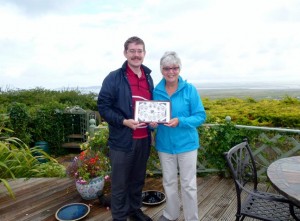
Volodymyr Chernyshenko a Ukrainian bio chemist and translator contacted Marilyn Hughes through the Westward Ho! History Group website asking for information and help with a book he was translating into Ukraine for a publishing company. The book was Rudyard Kipling’s Stalky & Co which tells of schoolboy pranks during his time at the United Services College in Westward Ho! After months of e-mails he asked if she would show him around as he was visiting the United Kingdom and really wanted to visit the village where Kipling had spent 4 years of his life.
They visited the college which is now flats and some of the other sites mention in the book. Vololdymr is a great fan of Rudyard Kipling and was thrilled to be treading in his footsteps. He presented Marilyn with an illustration which a Ukrainian artist had done of the teachers and boys for the book which will be given to the village hall.
Rear of United Services College:
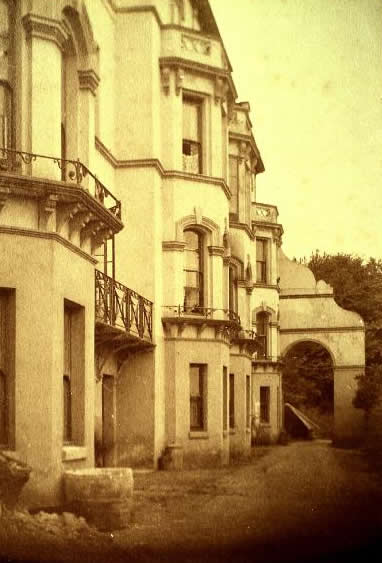
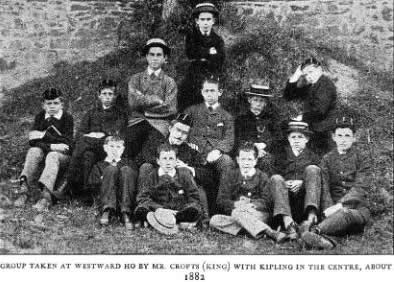
The Baths in Kiplings time, later became the Patio pool, now Nautilus apartments:
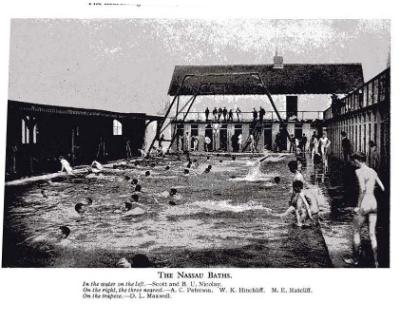
A cricket match with the college in the background:
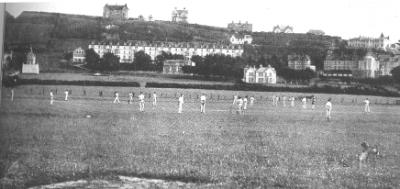
U S C with Edgehill in background:
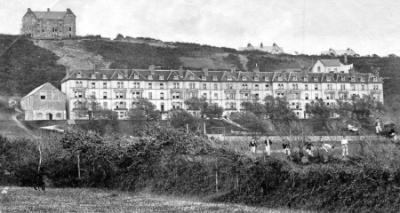
The United Services College later a Youth hostel:
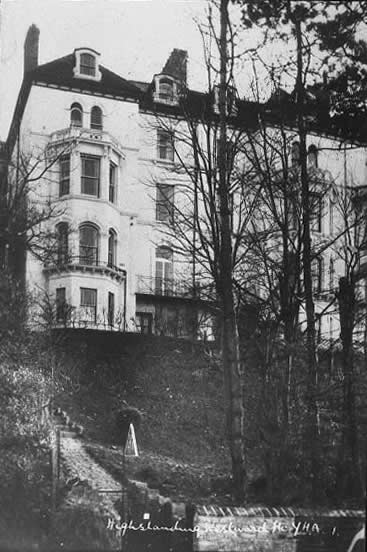
Clearing the Ivy from the Memorial Plaque:
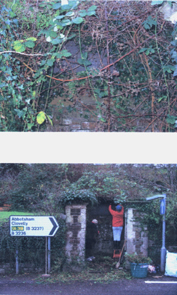
Situated by the entrance to the original steps leading up to the United Services College – Kipling Flats
The device to the left of the inscription is the School crest of a Bible on which appears the motto ‘Fear God, Honour the King’. This is superimposed on a crossed sword and fouled anchor,flanked by the military and naval crowns.
The Bideford and District Post for March 2010 carried an excellent feature article by Marilyn Hughes of the WHCHP on the complete history of U S C from 1874-1904, and the Junior School which was started in 1879.
